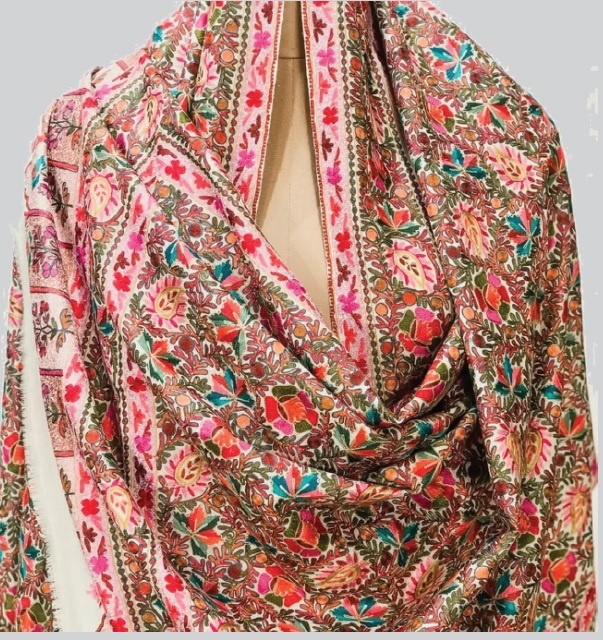A family from Seer Hamdaan area of south Kashmir’s Anantnag district are crafting captivating Kashmiri shawls by using painting designs on them. The unique art has gained popularity among the locals.
Mohammad Ayub Lone, a local, has trained more than 200 craftsmen in the valley and is associated with Shawl designing for several decades.
Lone makes crafts with different styles of flowers, birds and animals on shawls that not only attract customers but generate good income.
While narrating his journey of shawl designing and its peak time in Kashmir, he said he was inspired by one of his relatives Abdul Aziz Dar. Later, Lone left his education midway and learned designing from the veteran artist (Dar).
“I was studying in 8th standard when I was inclined towards this art. After I developed an interest in work, I left my studies and joined a full-time craft artist. I used to make any painting and then use the same design in shawls,” he said.
Out of a 5-member family, Lone along with his wife and daughter, are keeping the age-old legacy alive and striving hard. His daughter has taken the lead in learning the unique art and is currently pursuing her graduation.
Lone, is a well-known master craftsman called ‘Vasta’ (senior craftsmen) in his area and many people including young artisans admire him for his skills.
“Shawl designing is a symbol of artists’ perseverance, dedication and hard work. It involves a lot of time and patience of a craftsman,” he said.
The veteran artist said he was more inclined toward paintings of nature and animals which got him fame among people.
“I designed hundreds of shawls and made them attractive. I could not afford it as there was always a dearth of money in the field. Each piece of mine is a masterpiece,” he said.
For those who religiously consider their artwork as worship or prayer, it sometimes takes more than a year or two, to create a masterpiece. The artisan, as well as the customer, takes a lot of pride in creating and wearing,” Lone said.
He said in present cultural scenario and economic environment, when mechanization is considered the most profitable for mass production, these craft traditions face serious challenges and many of Indian heritage skills are at risks of being lost forever
The veteran artist said the design work on Kashmiri shawls requires hard work, dedication and concentration of a maker. “This form of art is quite different from other types of embroidery,” he said.
Kashmir’s handloom sector has a unique place in the socio-economic structure of the valley and women have time and again contributed for it.
With hard work and dedication, Lone’s wife and daughter also help him in the shawl making, designing and this is the source of livelihood for them.
Lone believes designing shawls is the most respectable job but over the past several decades, craftsmen were neglected by the government and were provided any kind of welfare.
“Although many schemes were initiated by the government, benefits were only provided to selective persons only,” he said.
“Shawl weaving is a generational art. Since labourers are unable to earn more than Rs 150 a day, weavers have stopped teaching the art to their children, thereby endangering it. Out of my three children, only my daughter is interested to continue and take this legacy forward,” Lone said.
The 42-year-old artist said skills are a gift of nature, which they are using not only to promote this heritage but also to provide employment for themselves and others.
In his village, Lone is a first-generation Kashmir shawl-maker. His family was in the same business, but he chose shawl designs for better returns.
“We need to save art forms because these are our main source of income. The exporters still have the potential to change their business. The artisans have nothing but their art which keeps them going for the work,” he said.
Lone said the middlemen have also reduced the number of knots per square which has been done to cut costs. However, it produces lower-quality shawls, which has also led to the downfall in the image of Kashmiri shawls across the globe.
Lone is not only a designer but also a trainer. He has been training young artists in order to encourage them to learn the art.
“They are trained. We also give training to people who are interested in making shawls and other handicrafts. It has generated hope as many artisans have left the traditional art and are coming back now,” he said.
Lone said it becomes obligatory for us to support the work of artisans, facilitate and motivate them to maintain the craft. It would also encourage the upcoming younger generation to enthusiastically learn, innovate, and create their individual styles, along with carrying on the legacy and not worrying about financial issues and fame.
Kashmiri shawls have a rich history and have been in vogue across the globe for centuries. However, technological limitations in the market have led to the decline of authentic Kashmiri design.
Shabnum Bano, Lone’s daughter, said she also helps her father in order to keep the craft alive. “I do not hesitate to work with my father. It gives me pleasure to work with him,” she said.
“We are not making much money and are yet leaving no stone unturned to preserve the generations-old art”, Bano said.








